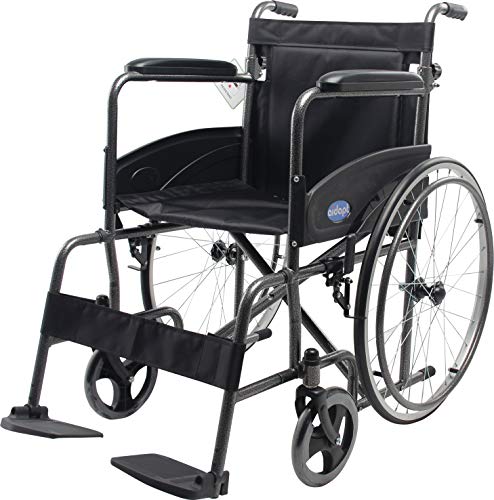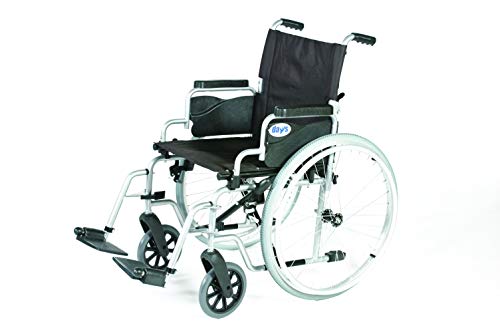Community
커뮤니티| You'll Be Unable To Guess How To Use A Self Propelled Wheelchair's Tricks(45.88.101.3) | |||||
| 작성자 | Williams | 작성일 | 24-11-10 20:42 | 조회 | 13 |
|---|---|---|---|---|---|
관련링크 How to Use a Self Propelled Wheelchair How to Use a Self Propelled WheelchairWheelchairs offer independence and mobility for those with limited walking ability. It is crucial to learn how to move your chair and get a therapist or occupational therapist to train you in this area. Wheelies are a common method to move a wheelchair. This requires the user to have hands that are large enough to span these rims and have strong grip strength to propel forward. Seating Position Like the name suggests best lightweight self propelled wheelchair-propelled wheelchairs allows you to move around and not rely on others. This is the key for many who want to regain their independence or retaining it. It also reduces the risk of injury to the person who is using the wheelchair as well as those surrounding them. The person using the wheelchair must be comfortable in the chair. There are several things to do to make sure this is the case. First, the footplates should be placed in the proper position. Release the latch on the footrest and then move the footrests to make sure they are directly in front of the chair. Make sure that the wheelchair user can comfortably place their feet on the footplates and there is even pressure beneath their feet. It could be necessary to lower the height of the footrest especially if the person is hemiplegic. If the footrests are not high enough, they can put pressure on the spine and increase pain and discomfort. A forehead strap can assist the wheelchair user to stay straight, particularly if their neck muscles are weak. These can be adapted by a mobility specialist and can be used with wheelchairs that don't include headrests. If the wheelchair has armrests it is important to ensure they are in a proper position and that the wheelchair user can move without hitting their arms as they move. It is recommended to use an armrest that is swing-away or removable armrests for this purpose. Alternatively, foam inserts can be cut and put on the back of the armrest to raise them up to a more comfortable height. It is also essential that the wheelchair has a properly-fitting cushion, especially if the wheelchair user has a high chance of skin breakdown or pressure ulcers. Pressure ulcers are caused by friction between the skin and the surfaces of a wheelchair. In some cases blisters and skin irritation can occur when sitting in one position for a long period of time. Repositioning the wheelchair regularly can help reduce the risk of developing pressure ulcers. Pushing lightweight self propelled wheelchairs-propelled wheelchairs allow users to move on their own and free themselves from the need for a third party to push them. They are more maneuverable due to their larger rear wheels and push handles. They can travel across many surfaces without worrying about tripping over obstacles or getting stuck. Be careful not to grip the chair handle too tightly when you move forward. Overly pressure can cause your hands to cramp and reduce how much force you are able to apply. You might also find it useful to wear a handrim cover or wheelchair gloves with grip materials built into the palms. This will improve the positioning of your hands and increase the force you can apply. It is important to keep the front casters clear of any debris, such as rocks and sticks. If the casters are covered with this type of material, it can make it difficult to move as you would expect from your wheelchair and could cause a loss of control and/or injury. If the height of your seat to floor is very high, you might think about adding additional padding to the front casters. It is recommended that a caregiver push the wheelchair to help you climb a curb or a small step. If you'd like to accomplish this yourself, you'll require additional training and experience under the supervision of an expert in health care. When doing this, it is important that you position the wheelchair facing directly towards (perpendicular to) the curb or take a small step and then place the front wheels close to the edge of the curb. When you're pushing up a hill, it is essential to have a clear space ahead of you to ensure you don't get in the way of other people. You will gain speed quickly if you don't leave enough space ahead of you. You may also collide with someone else. You can prevent this from happening by being aware of other people around you while on the slope. Also, you should have someone with you to catch you if you fall off your wheelchair. Braking A self propelled all terrain wheelchair propelled wheelchair requires the user to perform the braking and guiding actions in a particular way to ensure that the chair is safe to use. This is particularly crucial when on a slope as it is possible for the chair's center of gravity to move forward if the braking action is not applied in a controlled way. Always make sure that your hand is in the right position when pushing the wheelchair. Ideally, you should place it at 10 clock (10:00) on the wheel. Release the hand around 2 o’clock (2:00). This will ensure that the majority (or weight) of the body what is a self propelled wheelchair placed over the rear wheels, making it easier to push. It also helps to maintain the integrity of shoulder the elbow, wrist and wrist joint. To turn right in a wheelchair push forward on the right rim and then pull back the left rim. This causes the wheelchair to turn left and allows you to remain seated in your wheelchair. Wheelchairs can also be fitted with anti-tip bars that prevent the chair from tipping in the reverse direction. Refer to the user's manual that comes with your wheelchair for the most safe slope your chair can traverse. In certain situations the wheelchair may need to be temporarily dismounted and operated with a hand to climb steep slopes. In this situation, it is recommended that you ask a friend or family member to help and follow the steps in the User Guide. When negotiating kerb stones it is recommended that you remove and mount your vehicle using ramps whenever you are able to. This will minimize the amount of pressure required on the rear and front tyres and allow you to move over the kerb at a faster speed. Many manual wheelchairs feature a kerb-climber feature which can aid in this process. It improves the ability of the wheelchair to climb by around 10cm (4") To stop a wheelchair simply release the brakes and push the joystick towards you. This will break the clutch on the motor. The wheelchair will come to a halt which allows you to remove the footrests, put in walking aids and safely exit the chair. Steering When using a best self propelled wheelchair-propelled wheelchair the user is responsible for steering and controlling. This can be accomplished in various ways, dependent on the structure of the wheelchair and any accessories such as armrests or phone and drink holders. Wheelchairs vary in structure and size, as well as weight. The size of the front casters, for example can determine the kind of terrain that a wheelchair will be able to handle. Small casters allow a chair to move faster however they are unable to handle rough surfaces like cobblestone or grass. Large casters will allow wheelchairs to move over rough surfaces, but they will not be as swift. The user of a wheelchair must use both hands on smooth flat surfaces to keep momentum. This is accomplished by grabbing the hand rims and pushing evenly with each hand. The hands should not be encased around the rims of the hand in order to avoid injury and can lead to over-corrections (fish-tailing) when the chair makes a turn. It is recommended that wheelchair users experiment with different levels of leaning forwards and backwards to find the ideal balance between control and lean. The person using a wheelchair must anticipate obstacles and plan ahead for more difficult terrain. It is crucial that the user of the wheelchair looks over his or her shoulders regularly to avoid hitting objects or other people. Likewise, if they are travelling with a caregiver, they should make sure that they are able to assist if required. If the wheelchair will be placed on a slope, a caregiver must assist or drive it until the user is comfortable with this. To turn the wheelchair, the user must push one hand rim forward while pushing the opposite rim back. The user of a wheelchair should practice this on a smooth, level ground before trying it on other surfaces, as the motion may be uncomfortable and the chair may easily tip over if the action is not mastered. The power wheels on the wheelchair can ease the pressure on the user and help with turning. It is essential to be aware that strangers who are not trained will often push a wheelchair user against their will. The wheelchair user must cover the handles or fold them back.  |
|||||
